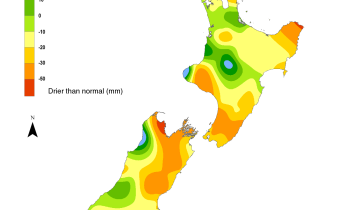In the 2010 NIWA Report on the seven-station temperature series (Mullan et al., 2010), two alternatives were offered for the adjustment at January 1945 between the records for Hokitika Town and Hokitika Southside. An offset of -0.52°C (a negative value meaning the new site is colder) was calculated by comparing the changes at Hokitika from 1935-1944 to 1945-1954 with those at four comparison sites. An offset of ‑0.68°C was calculated from a direct comparison between the two Hokitika records from the overlap of 30 months for August 1943 to January 1946. The second offset (‑0.68°C) was the one accepted in the 2010 Report.
On further consideration, it was decided that an adjustment of -0.52°C was more appropriate; this reduces the Hokitika trend from +1.11°C/century (NIWA 2010 Report) to +0.89°C/century over the 1913-2009 period. Updating to 2015, the Hokitika trend in mean temperature over 1913-2015 is +0.93 ±0.32°C/century.

Figure 1: Difference in monthly mean temperature between Hokitika and the average of Appleby (agent 4239) and Kelburn (agent 3385), for Hokitika Town (agent 3907, red) and Hokitika Southside (agent 37939, blue). The horizontal dashed lines show the average levels for the respective Hokitika stations, which have a difference of 0.52°C.
Figure 1 shows the difference between the Hokitika temperatures and the average of temperatures at the two comparison sites of Appleby (Nelson) and Kelburn (Wellington), over the longer period 1932-1964, where the offset is also -0.52°C. Close inspection of the graph reveals two important features:
- The Hokitika Town temperature was unusually low (relative to its comparison sites) over about a year up to July 1943, very likely as a consequence of the deteriorating conditions of the Stevenson screen which were not discovered until extreme rainfall on 27 July 1943 caused flooding at the site. A subsequent site inspection revealed that the Stevenson screen was in very poor condition: “Most of the louvres had fallen off, the roof was rotten, and it needed painting” (Fouhy et al., 1992).
- After the screen was repaired (i.e., from August 1943) to the end of the Hokitika Town record (January 1946), the Town temperatures were slightly higher than previously, relative to the comparison sites.
After the screen refurbishment, the Hokitika Town temperatures were slightly higher than those before about mid-1942, and hence the longer-term offset of 0.52°C is preferred. (This is very close to the January 1932 to mid-1942 offset.) Note also that the erroneously low mean temperature during 1942/43 (even worse for the minimum temperature) is a good example of why it is unwise to use very short comparison periods for estimating the effect of site changes.
References:
Fouhy, E.; Coutts, L.; McGann, R. P.; Collen, B.; Salinger, M. J. (1992). South Pacific Historic Climatological Network Climate Station Histories. Part 2: New Zealand and Offshore Islands. NZ Meteorological Service, Wellington, ISBN 0-477-01583-2, 216 p.
Mullan, A.B.; Stuart, S.J.; Hadfield, M.G.; Smith, M.J. (2010). Report on the Review of NIWA's 'Seven-Station' Temperature Series. NIWA Information Series No. 78, ISSN 1174-264X, 175p.






